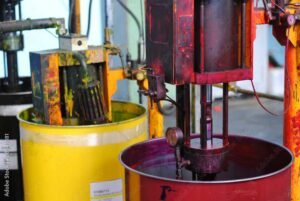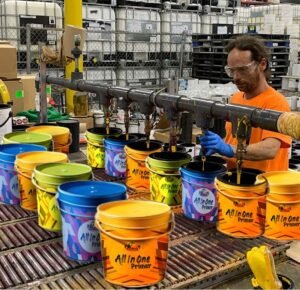Introduction to Home Paint Manufacturing in India
The home paint manufacturing industry in India plays a significant role in the overall economic landscape, serving as a vital component of the construction and housing sectors. Over the years, this industry has witnessed substantial growth, driven by increased urbanization, rising disposable incomes, and evolving consumer preferences. The surge in residential and commercial construction projects has further amplified the demand for high-quality home paints, including innovative products that meet aesthetic and functional needs.
The industry has transitioned from basic offerings to a diverse array of formulations catering to modern requirements. This includes eco-friendly options, water-based paints, and specialized products designed to withstand various climatic conditions, ensuring durability and longevity. Furthermore, the growing awareness regarding the health impacts of certain chemicals has prompted manufacturers to invest in research and development, leading to the emergence of safer alternatives in the market.
As of the latest estimates, the home paint segment is projected to grow at a rapid pace, outpacing other sectors within the construction industry. Market players have been focusing on sustainability, leveraging technology to create paints that minimize environmental impact. This not only reflects the changing consumer mindset towards eco-responsible products but also aligns with global trends emphasizing greener practices.
In addition to catering to residential projects, the industry has expanded its reach into the commercial sector, offering customized solutions for offices, retail spaces, and hospitality venues. This diversification showcases the adaptability of the mithila home paint segment, as it strives to meet the dynamic needs of various markets. The robust growth trajectory, coupled with innovations in products and sustainability practices, reinforces the significance of home paint manufacturing in driving economic development and enhancing the quality of living spaces across India.

Historical Perspective of Paint Manufacturing in India
The history of paint manufacturing in India can be traced back to ancient times when natural pigments derived from plants, minerals, and earth were utilized to create colors for decoration and aesthetics. This traditional practice laid the groundwork for what would evolve into a more structured and industrialized system of home paint production. By the 16th century, with the influx of foreign influence and trade, the art of painting progressed significantly, seeing the introduction of innovative techniques and materials.
The 19th century marked a pivotal era in India’s paint manufacturing evolution. The establishment of modern factories and the arrival of European manufacturers heralded a shift towards synthetic paints. The incorporation of chemical compounds helped enhance color durability and application ease. By the mid-20th century, India witnessed the emergence of local companies that began producing various paint products, catering to the burgeoning demand for home paint solutions.
The post-independence period in India saw significant advancements in technology and manufacturing processes. The introduction of mechanized production techniques and quality control practices contributed to the growth and standardization of the paint industry. This was further facilitated by government policies that encouraged local manufacturing and foreign collaboration, leading to the establishment of several notable paint brands. Home paint solutions began to diversify, with increasing options ranging from water-based to oil-based paints for both residential and commercial applications.
As the new millennium approached, the focus on eco-friendly and sustainable products began to reshape the market landscape. Innovations aimed at reducing the environmental impact of home paint became increasingly relevant. Consequently, manufacturers adapted their offerings, leading to the development of non-toxic paints and products featuring low volatile organic compounds (VOCs). Today, the Indian paint industry stands as a testament to the rich historical legacy and dynamic evolution that continues to respond to modern consumer needs.
Raw Materials Used in Paint Production
Home paint manufacturing relies on a variety of raw materials that are essential to producing high-quality paint. Among these, pigments, solvents, resins, and additives play crucial roles in determining the final product’s aesthetics and performance. The use of these materials ensures that the paint is not only visually appealing but also durable and robust.
Firstly, pigments are responsible for imparting color to the paint. They can be organic or inorganic, and each type has distinct qualities that affect the paint’s opacity and brightness. In the case of mithila home paint, choosing the right pigments is vital to achieve vibrant shades that can withstand fading due to sunlight exposure. Quality pigments provide the necessary coverage and enhance the overall visual identity of the paint.
Solvents are another critical component in paint formulation. They serve to dissolve other ingredients and aid in the application process. Solvents can be water-based or oil-based, with each type significantly influencing the paint’s drying time and ease of use. For instance, water-based mithila home paint tends to dry faster, thereby allowing for quicker project completion. Proper solvent selection also affects VOC levels, which are important for indoor air quality.
Resins or binders are the structural backbone of paint. They help hold the pigment particles together and adhere the paint to surfaces. The type of resin used can determine the paint’s durability, gloss level, and water resistance. In the context of mithila home paint, high-quality resins are fundamental in extending the lifespan of the coating and providing protection against environmental factors.
Lastly, additives are included to enhance certain properties of the paint, such as flow, stability, and mildew resistance. These materials fine-tune the performance characteristics of the paint, ensuring that it meets both aesthetic and functional standards. Collectively, these raw materials form the foundation of effective paint production, allowing manufacturers to create products that perform well and meet consumer expectations in India and beyond.

Manufacturing Process of Home Paints
The manufacturing process of home paints involves several critical stages, each contributing to the final product’s quality and performance. The journey begins with the formulation, where raw materials are carefully selected to achieve the desired characteristics of the paint. Key components, such as pigments, binders, solvents, and additives, are combined to create a homogenized mixture. This stage requires precise measurements and a thorough understanding of the chemical interactions between the various ingredients.
Once the formulation is finalized, the next step is grinding, wherein pigments are blended into the binder, creating a uniform color and consistency. This process typically involves the use of high-speed dissolvers or bead mills, which efficiently break down the pigments and disperse them throughout the binder. Attention to detail in this stage is crucial, as it significantly influences the paint’s opacity, color strength, and finish quality.
After grinding, the mixture undergoes a process called “let-down,” where additional binders and solvents are introduced to achieve the appropriate viscosity and application properties. This step ensures that the mithila home paint can be easily applied and adhere properly to various surfaces. Computer-controlled rheometers may be employed to precisely monitor and adjust the viscosity of the paint according to predetermined specifications.
Once the paint reaches the desired consistency, it moves to the filtration stage to remove any agglomerates or impurities that could affect performance. Following filtration, the paint is packaged for distribution. The packaging process must adhere to stringent quality standards to ensure that the paint retains its properties throughout its shelf life. This includes using suitable containers that prevent contamination and facilitate easy application.
Overall, each phase of the home paint manufacturing process is designed to ensure that the final product meets the highest industry standards and customer expectations. The systematic approach in production not only enhances quality but also ensures that the applied paint, such as mithila home paint, delivers durability and aesthetic appeal.
Major Players in the Indian Paint Industry
The Indian paint industry has seen significant growth over the past few decades, characterized by innovation and fierce competition among its key players. Leading this industry are several established companies that have played a crucial role in shaping the landscape of home paint manufacturing in India. Among them, Asian Paints, Berger Paints, and Nerolac Paints stand out for their extensive market shares and diversified product offerings.
Asian Paints, founded in 1942, is the largest paint company in India, with a market share exceeding 40%. The company’s success is attributed to its strong distribution network and innovative marketing strategies. Asian Paints provides a wide range of products, including decorative finishes, industrial coatings, and specialized solutions like the eco-friendly mithila home paint line, which emphasizes sustainability. Their commitment to research and development has driven the introduction of advanced technologies in paint formulations, making them pioneers in the industry.
Berger Paints, another significant player, holds a market share of approximately 15%. Founded in 1923, Berger has established itself as a trusted name in providing high-quality decorative paints and coatings. Their mithila home paint products are particularly popular among consumers looking for vibrant colors and durability. The company’s focus on regional preferences and customization has enhanced its appeal in various markets across India.
Nerolac Paints, a subsidiary of Kansai Paint, commands around 12% of the market share. With a legacy of over 100 years, Nerolac specializes in decorative paints and industrial coatings. The company is recognized for its environmentally friendly products, including the mithila home paint range, which caters to the growing demand for sustainable home solutions. Their strong emphasis on customer satisfaction and extensive research has positioned them well within the competitive landscape.
Overall, these key players have not only contributed to the growth of the Indian paint industry but have also set high standards in terms of quality, innovation, and sustainability, significantly influencing the preferences of consumers across the nation.
Market Trends and Consumer Preferences
The Indian home paint market has witnessed significant transformation over the past few years, driven primarily by evolving consumer preferences and a growing consciousness about the environment. One of the most notable trends is the rising demand for eco-friendly options. Consumers are increasingly opting for paints that are low in volatile organic compounds (VOCs) and free from harmful chemicals. This shift is reflective of a wider global movement towards sustainability, wherein consumers seek not only aesthetic appeal but also a product that contributes positively to their living environment. Consequently, several manufacturers, including those producing mithila home paint, have begun to prioritize green formulations in their product lines.
Color preferences among Indian consumers are also changing, often influenced by cultural trends, social media, and interior design inspirations. Traditionally, vibrant colors have dominated the Indian homescape; however, there is a discernible shift towards more pastel and muted tones. Shades that evoke tranquility and warmth are gaining popularity, particularly in urban settings where individuals seek respite from the hustle and bustle of city life. The choices made by consumers indicate a growing sophistication in understanding how color can influence mood and space perception, thus affecting their decisions while selecting home paint.
Furthermore, consumer preference for specific finish types is evolving. In recent times, there has been an increasing trend towards the use of matte and satin finishes rather than high-gloss options. Matte finishes, in particular, are favored for their non-reflective surfaces, which can create a soothing ambiance, thereby aligning with the rising emphasis on comfort within the home. These trends are indicative of a more informed consumer base, making selections based on functionality, aesthetic appeal, and environmental impact. As these dynamics continue to develop, manufacturers must adapt to resonate with changing consumer behaviors and preferences in the home paint sector.
Challenges Faced by Paint Manufacturers in India
The home paint manufacturing sector in India has been experiencing significant evolution in recent years, but it also encounters numerous challenges that impact growth and sustainability. One of the primary hurdles is regulatory compliance. Manufacturers must adhere to stringent regulations set by government bodies concerning quality standards, safety protocols, and environmental guidelines. These regulations can be complex and often vary at regional and local levels, making adherence costly and time-consuming. Failure to comply can lead to severe penalties, hampering operational efficiency.
Another major issue is the fluctuating prices of raw materials. The paint industry relies on a variety of essential components, such as pigments, solvents, and resins, which can experience dramatic price volatility due to market demand, global trade dynamics, or supply chain disruptions. Such fluctuations make it challenging for mithila home paint manufacturers to maintain competitive pricing while ensuring margin profitability. These costs can also be passed on to consumers, potentially impacting sales.
Moreover, competition from the unorganized sector presents a significant challenge. Many small manufacturers operate without the same quality constraints that larger firms adhere to, leading to unfair pricing competition and market dynamics. This undermines the business for established brands committed to quality and sustainability, including those producing mithila home paint. Without intervention, this situation can erode market share and dilute brand recognition among consumers who seek trusted products.
Additionally, the increasing global focus on sustainability and environmental impact prompts manufacturers to reconsider their production processes and product ingredients. Many consumers are moving towards eco-friendly options, pressuring companies to innovate while balancing costs. This transition requires investment in research and development, which can strain resources. Thus, navigating the complex landscape of regulatory, economic, and environmental challenges is critical for the growth of the home paint manufacturing industry in India.
Future Outlook of Home Paint Manufacturing in India
The Indian home paint manufacturing industry is on the brink of significant transformation, driven by innovative technologies, an increasing emphasis on sustainability, and the burgeoning demand for customized solutions. As consumers become more environmentally conscious, manufacturers are compelled to adopt eco-friendly practices in their product lines, such as the development of low-VOC (volatile organic compounds) paints that are less harmful to both health and the environment. This shift not only meets regulatory requirements but also boosts the appeal of products like mithila home paint among discerning buyers.
Technological advancements are expected to play a pivotal role in the future of home paint manufacturing. The integration of digital tools in paint formulation and application processes is making the production cycle more efficient. Innovations such as artificial intelligence and automation are streamlining operations while enhancing quality control. Additionally, the rise of smart home technology is poised to influence industry trends, leading to the creation of paints that can adapt to changing environmental conditions, potentially revolutionizing the way consumers view home paint products.
Moreover, the Indian paint market is witnessing robust expansion, fueled by the growth of the real estate sector and rising disposable incomes. With urbanization and an increasing number of housing projects, the demand for quality home paint, including specialized products like mithila home paint, is expected to escalate. Companies are focusing on marketing strategies that emphasize personalized services, engaging consumers through innovative channels and offering tailored solutions to meet specific aesthetic and functional requirements.
Overall, the prospects for home paint manufacturing in India are promising, characterized by a blend of sustainability, technological efficiency, and responsive customer service. As the industry navigates these changes, it remains essential to monitor developments closely to understand their impacts on marketplace dynamics and consumer preferences.

Conclusion
The evolution of home paint manufacturing in India represents a significant facet of the nation’s economic landscape, showcasing how innovation and technology have redefined this industry. Throughout our discussion, we observed how the introduction of water-based paints and eco-friendly solutions has not only enhanced product quality but has also addressed growing environmental concerns. This is particularly relevant in the context of the increasing urbanization and rapid construction developments across various Indian cities, which have been pivotal in driving demand for high-quality mithila home paint.
Furthermore, we highlighted the crucial role that various stakeholders, including manufacturers, suppliers, and consumers, play in shaping the future of the home paint sector in India. The increasing preference for aesthetic appeal and durability in paint products has led to a competitive market, pushing manufacturers towards research and development to stay ahead. Mithila home paint exemplifies this shift, incorporating both traditional art forms and modern technology to create unique offerings. These approaches not only cater to consumer preferences but also contribute to the preservation of cultural heritage.
Looking ahead, the home paint manufacturing industry in India is poised for further transformation. With the rise of smart technology, manufacturers may continue to innovate towards sustainable practices. Emerging trends such as the use of artificial intelligence in production, and the growing emphasis on health-conscious options, will likely shape the future of mithila home paint and related products. Additionally, as younger generations become more environmentally aware, there will be a substantial demand for eco-friendly paint alternatives. Thus, the trajectory of home paint manufacturing in India remains promising, reflecting broader economic trends and societal shifts.

